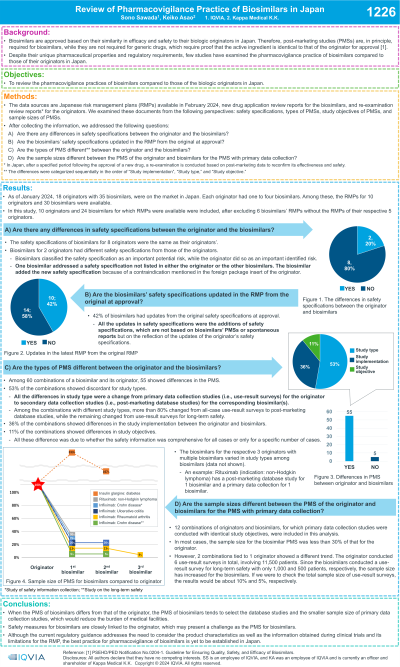BRACE, health policy, guidance documents
Session: Poster Session C
(033) Review of Pharmacovigilance Practice of Biosimilars in Japan
Wednesday, August 28, 2024
8:00 AM - 1:30 PM CEST
Location: Convention Hall II

- SS
Sono Sawada, MHsc
Sr consultant
IQVIA, Japan - KA
Keiko Asao, MD, PhD
Principal
IQVIA Solutions Japan G.K., Japan
Presenting Author(s)
Co-Author(s)
Background: Unlike generic drugs, which require proof that the active ingredient is identical to that of the originator, biosimilars are approved based on their similarity in efficacy and safety to their originators in Japan. Therefore, post-marketing studies (PMSs) are, in principle, required for biosimilars, but not for generic drugs in Japan. Despite their unique pharmaceutical properties and regulatory requirements, few studies have examined the pharmacovigilance practice of biosimilars in comparison with those of their originators in Japan.
Objectives: To review the pharmacovigilance practices of biosimilars in Japan in comparison with those of the originators.
Methods: Biosimilars marketed in Japan as of January 2024 were examined with respect to the following perspectives and compared with their originators: safety specifications, types of PMSs (use-results surveys vs. database studies), study objectives of PMSs, and sample sizes of PMSs. The data sources are the latest Japanese risk management plans (RMPs) and those at the time of approval, new drug application review reports, and re-examination review reports.
Results: As of January 2024, 18 biologic originators with 35 biosimilars, in total, were on the market in Japan. Each originator had one to four biosimilars. Among them, the RMPs for 10 originators and 30 biosimilars were available, including 6 biosimilars’ RMPs without the RMPs of their respective originators (5 originators). The RMPs for originators and biosimilars were not available if they were approved before the RMP system was initiated in Japan in 2013 (8 originators; 5 biosimilars).
All biosimilars for 8 originators had the same safety specifications as the respective originators, while some biosimilars for 2 originators showed differences in safety specifications from their originators, such as having an additional safety specification. There were biosimilars for 5 originators for which these confirmations could not be made due to the absence of the RMP for their respective originators. In terms of PMSs, some biosimilars planned to conduct the same type of studies with similar study objectives as their respective originators, while others did not. In cases where multiple biosimilars were on the market for an originator, there were three cases where one of the biosimilars planned a database study, but others planned use-results surveys, even though they shared the same originators.
Conclusions: In Japan, although the regulatory guidance addresses the need to consider the product characteristics, information obtained during clinical trials, and its limitations, etc., when developing the pharmacovigilance activity of biosimilars, the pharmacovigilance practice for biosimilars seems yet to be established.
Objectives: To review the pharmacovigilance practices of biosimilars in Japan in comparison with those of the originators.
Methods: Biosimilars marketed in Japan as of January 2024 were examined with respect to the following perspectives and compared with their originators: safety specifications, types of PMSs (use-results surveys vs. database studies), study objectives of PMSs, and sample sizes of PMSs. The data sources are the latest Japanese risk management plans (RMPs) and those at the time of approval, new drug application review reports, and re-examination review reports.
Results: As of January 2024, 18 biologic originators with 35 biosimilars, in total, were on the market in Japan. Each originator had one to four biosimilars. Among them, the RMPs for 10 originators and 30 biosimilars were available, including 6 biosimilars’ RMPs without the RMPs of their respective originators (5 originators). The RMPs for originators and biosimilars were not available if they were approved before the RMP system was initiated in Japan in 2013 (8 originators; 5 biosimilars).
All biosimilars for 8 originators had the same safety specifications as the respective originators, while some biosimilars for 2 originators showed differences in safety specifications from their originators, such as having an additional safety specification. There were biosimilars for 5 originators for which these confirmations could not be made due to the absence of the RMP for their respective originators. In terms of PMSs, some biosimilars planned to conduct the same type of studies with similar study objectives as their respective originators, while others did not. In cases where multiple biosimilars were on the market for an originator, there were three cases where one of the biosimilars planned a database study, but others planned use-results surveys, even though they shared the same originators.
Conclusions: In Japan, although the regulatory guidance addresses the need to consider the product characteristics, information obtained during clinical trials, and its limitations, etc., when developing the pharmacovigilance activity of biosimilars, the pharmacovigilance practice for biosimilars seems yet to be established.
